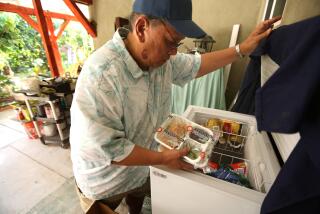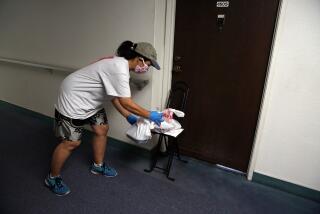The Hungry Suffer Another Pain--Sharing Their Secret
While working on a story about hunger in Orange County, I made my way down the food line at a Costa Mesa emergency center, where more than 100 people, mostly women with small children, were waiting for bags of free groceries.
As I approached each one, an odd pleading smile would spread across her face. Asked to talk, she would look away, mouth clamped shut, head slowly shaking, “No.”
It was bad enough to have to stand in line for anyone passing by to see, their faces seemed to say. But to have to explain it to a stranger who would publish it in the newspaper was just too much.
Although I understood their reluctance to talk, I knew that my story would rise or fall on the human examples I could find to call attention to their situation and make it tangible to a reader. That required exposing the intimate details of their poverty, and, in the process, exposing them.
The director of a lunch program for senior citizens at the center agreed to introduce me to some of the low-income clients she serves.
One after another, they filed into her office for private interviews. Giddy at the thought of speaking to a reporter, they happily gave their names and ages and told how many children they had. But when asked why they came for the hot lunch, they shifted uncomfortably in their chairs and spoke of the pleasures of bingo and the wonderful friends they had made at the center.
To be sure, companionship was a powerful draw for many of them, dwelling alone on meager fixed incomes, having outlived their spouses and most of their friends. But I knew they also came because they needed the food.
In whispers, the director had pointed out one woman who had been eating from the trash--before a doctor diagnosed her as malnourished and sent her to the feeding program--and another who could hardly afford her rent increase, much less proper food.
(I later asked the first woman what she ate besides the center’s hot lunch. At her age, she said, she hadn’t the appetite to eat more than one meal a day.)
Go to any grocery store and you’ll find old men and women buying dog food, the director told me when I protested that no one would admit to their circumstances. But if you ask them why, she continued, they’ll lie and say it’s for their pets.
Hunger, it seemed, was a badge of poverty, stark and humiliating. And most of the people I met who were poor enough for hunger to be an ever-present threat were doing all they could to keep it a secret.
Eventually, I found the people I needed to illustrate my story. And their tales were powerful enough to elicit the curious mixture of voyeurism and sympathy that often moves a reader to action.
One woman telephoned because she wanted to befriend a 95-year-old woman whose only meal came from the hot lunch program. Another, writing that the story had “tweaked” her conscience, sent in a check for a disabled former limousine driver.
The former driver had spoken movingly of the humiliation of having to accept handouts after having worked hard all her life. I stifled the queasy feeling that I had exposed her to the pity of strangers, remembering how she had persuaded herself to talk to me.
“President Reagan reads the paper, right?” she had asked with affecting naivete. “The politicians read it. Maybe it will make them help us.”
A few days after the story was published, the former driver wrote me a thank-you note. She did not seem to regret her role in the story, but her letter included a line that bears quoting here.
“It is humbling to be poor,” she wrote, “but even more so to let the world know.”


